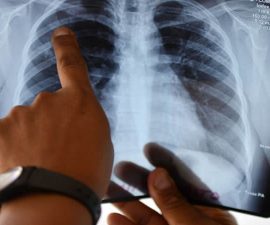Dyspnea on exertion can be attributed by a number of different causes. Even sometimes it’s a normal to have this symptom. For example, you can have it due to extreme temperatures or after a very strenuous exercise. But it can be a sign of particular medical condition, too. One of the most possible causes is emphysema, a serious respiratory disease that can lead to serious problems in the lungs.
What actually is dyspnea?
It is a medical term for shortness of breath /feeling of breathlessness. Typically, it is described as feeling of suffocation, tightening in the chest, or air hunger – making it more difficult to breathe. This sensation can be quite scary. Depending on the underlying cause of the problem, it may also occur even when the levels of oxygen in the circulation (bloodstream) are normal.
Healthy adults, with normal weight about 70 kg (150 pounds), will normally breathe at an average rate of 14 breaths per 60 seconds at rest. If you have dyspnea, this rate can drastically change when the symptom flares up.
Again it can be attributed by many different causes. Typically, it is a result of the problems affecting the lungs, breathing passages, heart, or blood vessels.
If dyspnea strikes suddenly (acute), it may be a consequence of one or some of the following conditions:
- Asthma, a chronic condition of the airways that can make your breathing difficult. It is incurable, but controllable. It may change over time and therefore should be regularly monitored.
- A sign of poisoning, such as carbon monoxide poisoning.
- Problems affecting the hearts such as heart attack, excess fluid buildups around the heart (cardiac tamponade), or heart failure.
- A sudden drop in blood pressure, hypotension.
- Problems affecting the lungs such as pulmonary embolism (blood clot that occur in a renal artery), collapsed lung (pneumothorax), or pulmonary infection (pneumonia).
- Problems affecting the breathing passages – upper airway obstruction, for example.
For chronic dyspnea (if it develops gradually and may last a few weeks or longer), the common possible causes are as follows:
- COPD, chronic obstructive pulmonary disease.
- Interstitial lung disease, a group of lung conditions that usually affect the space and tissue around the air sacs of the lungs.
- Other causes include poorly controlled asthma, obesity, heart dysfunction, deconditioning, and obesity.
Other health conditions that may contribute to cause shortness of breath are:
- Other lung problems such as lung cancer, pulmonary edema (fluid buildups in or/and around the lungs), scarred lungs (pulmonary fibrosis), high blood pressure that occur in the renal blood vessels (pulmonary hypertension), and tuberculosis.
- Heart problems such as rhythm problem (heart arrhythmias), problem affecting heart muscle (cardiomyopathy), and swelling of the membrane around the heart (pericarditis).
- Sometimes feeling of breathlessness may occur due to anemia, accidentally foreign object inhaled, generalized anxiety disorder, broken ribs, myasthenia gravis (muscle weakness condition), a severe allergic reaction, Guillain-Barre syndrome (autoimmune disorder), or swelling of windpipe’s part (epiglottitis).
The list mentioned above is intended for general information only! For more information, consult with a doctor!
Emphysema
It is a respiratory disease that usually causes enlargement of air sacs (alveoli) in the lungs, making it more difficult for breathing. Dyspnea on exertion is the common symptom of the disease. As the disease becomes advanced, the symptom can flare up anytime – not only on exertion. For example, shortness of breath in people with advanced emphysema may also occur even while at rest.
The symptoms may come and go (chronic)! Other symptoms of emphysema are as follows:
- A blue tinge to the skin (cyanosis), a sign of oxygen deficiency in the blood. The damaged alveoli can affect the gas exchange between oxygen that starts entering the blood and carbon dioxide that goes away from the circulation.
- Chest infections. As the disease gets worse, people with emphysema are more vulnerable to have chest infections.
- Phlegm production and persistent cough.
- The enlargement of alveoli will put more pressure on the ribcage. Over time, this may cause barrel-shaped chest.
- Fatigue is also quite common in emphysema. When the disease flares up, you may need more energy just for breathing.
The number of people with emphysema is quite high. It is a main type of a group of lung diseases called chronic obstructive pulmonary disease (COPD). As the name suggests, it is chronic and obstructive lung disease.
The word ‘obstructive’ means the disease causes difficulty in exhaling the air from the lungs. Even at the end of full exhalation, a high amount of air (higher than normal) may still remain and linger in the lungs, making it more difficult to breathe especially on exertion or during increased activity.
Emphysema and dyspnea on exertion at risk for …
Although the damaged alveoli can be permanent and there is still no cure for the disease – some effective treatments are available to help relieve the symptoms, preserve the lung function, and prevent the complications of the disease.
Again dyspnea, shortness of breath, especially on exertion is a common symptom of emphysema. Worsening dyspnea may signal that the disease is poorly controlled.
And poorly-controlled emphysema may put people with the disease at risk for the following serious complications:




